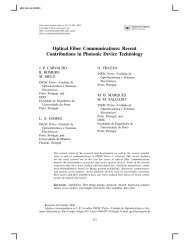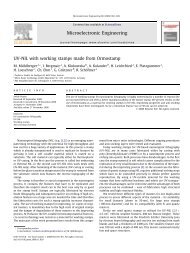Photosensitive Materials for Integrated Optic ... - ResearchGate
Photosensitive Materials for Integrated Optic ... - ResearchGate
Photosensitive Materials for Integrated Optic ... - ResearchGate
Create successful ePaper yourself
Turn your PDF publications into a flip-book with our unique Google optimized e-Paper software.
152 P. V. S. Marques et al.<br />
Figure 1. Flame hydrolysis deposition system calibration <strong>for</strong> germano-borosilicate glass. The<br />
SiCl 4 and BCl 3 flow rates were 150 and 65 cm 3 /min, respectively. The oxygen and hydrogen<br />
flow rates were 7 and 5 L/min, respectively.<br />
Photosensitivity Assessment and Device Fabrication<br />
Bragg gratings. Following FHD system calibration, the photosensitive response of<br />
germanium-boron–doped silica layers was assessed as deposited and after photosensitivity<br />
enhancement (either through cold hydrogenation or flame brushing).<br />
The refractive index changes in planar waveguides due to UV exposure were determined<br />
by protecting half of the sample while uni<strong>for</strong>mly exposing the other half. The<br />
changes were determined by comparing the refractive index of both areas, as given<br />
by the prism coupler and m-lines technique. The saturation values <strong>for</strong> index change in<br />
planar waveguides (core thickness of 6 µm and relative refractive index difference of<br />
n<br />
n<br />
= 0.75%) due to UV exposure, using a KrF excimer laser operating at 248 nm, were<br />
5 × 10 −4 <strong>for</strong> as-grown samples and 4 × 10 −3 <strong>for</strong> flame-brushed samples (due to the absence<br />
of a cladding layer, flame brushing employing an oxy-hydrogen torch [17] was used<br />
as the photo-sensitization method, since flame brushing induces permanent hydrogenation<br />
as opposed to “cold” hydrogenation at high pressure, where molecular hydrogen<br />
will rapidly diffuse out). In addition, Bragg gratings were written into standard channel<br />
waveguides defined by reactive ion etching and buried using a cladding layer, with<br />
the refractive index matching that of the thermal silicon dioxide buffer. Gratings were<br />
photo-imprinted using the conventional phase mask approach. The transmission spectrum<br />
evolution due to UV exposure through a 6-mm-long phase mask (period of 1060 nm) in<br />
an etched waveguide with a relative refractive index contrast to the thermal buffer layer<br />
of 0.75% and core dimensions of 6 × 6 µm 2 can be seen in Figure 2. The samples were





